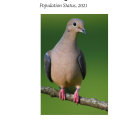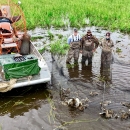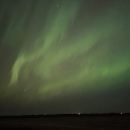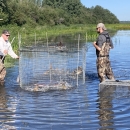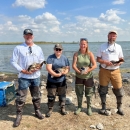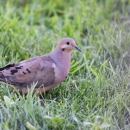Interested in how you can report a banded bird or how the U.S. Fish and Wildlife Service Migratory Bird Program uses this information? Maybe you'd like to know more about reward bands or what types of birds are banded? Read on to find the answers!
Reporting Banded Birds
If you have found or harvested a banded bird, please report it at www.reportband.gov. You'll need the band number, or numbers, if the bird has more than one band. See below for more information on reward bands. You'll also need to know where, when and how you recovered the bird. Your contact information will be requested in case there are any questions. The U.S. Geological Survey Bird Banding Lab (BBL) will send you a certificate of appreciation that includes information about the sex, age and species of the bird, and where and when it was banded. You can keep the band. Please note: Even if the band you recover is inscribed with a 1-800 telephone number, as of July 2, 2017, you can only report it at www.reportband.gov.
If some or all of the numbers have worn off, making the band unreadable, please email the BBL at bandreports@usgs.gov or find out on how to send the band for chemical etching. Most bands can be chemically etched so that the numbers can be read. The process does not destroy the band, and it will be returned to you. Thank you for helping conserve and manage migratory birds!
How We Use Banding Data
Managing a complex and mobile resource requires information on breeding and wintering distribution, behavior, migratory routes, survival and reproduction. Biologists gather this information by placing uniquely numbered bands on many species of birds. These birds may be recaptured in the future by biologists, or are found dead by the general public, or in the case of waterfowl or other game birds are harvested by hunters, who then report these bands to the U.S. Geological Survey Bird Banding Laboratory (or Canada’s Bird Banding Office), which provides information about where the bird was banded, where it was recovered, and how long it lived. This is the information that was used to develop the Flyway system that has been used for managing migratory birds since 1950.
The Division of Migratory Bird Management is involved in both the collection and analysis of banding data. Our staff coordinates with banders from various state, federal, private, and tribal agencies in ongoing, annual banding efforts. One example is the Western Canada Cooperative Waterfowl Banding Program (WCCWBP) which focuses on banding waterfowl throughout the Canadian prairies and Canadian boreal forest. Find out more about the program and read the stories of banding crews in the field.
Migratory Bird Program biologists and their counterparts in the U.S. Geological Survey have led the way in developing models that utilize banding and recovery data to predict the impacts of harvest and other take, as well as develop an understanding of environmental factors that drive migratory bird populations. Banding data were instrumental in the development of Adaptive Harvest Management and are used by biologists to set annual waterfowl hunting regulations.
The value of banding data is only fully realized when banded birds are recovered and band numbers reported to the Bird Banding Laboratory. Some recoveries are recaptures (including resighting of bands through spotting scopes) of live birds that are obtained from banders or other wildlife professionals. However, the predominant number of recoveries of dead birds come from the public, either by people who have found birds that have died, or by hunters who have harvested them. More information about how and where to report the recovery of banded birds can be found above under Reporting Banded Birds. We rely heavily upon on your cooperation, and we, and the birds, thank you.
Reward Bands
Harvesting a banded bird is a unique experience. Not only do you get some "jewelry" for your lanyard, but when you report the band, you get a certificate on when and where the bird was banded, and its species, sex and age. Getting a bird with a reward, or "money" band on it is extra special because they are relatively rare. And, oh yeah, the reward check is nice too.
We often get questions about the purpose of these bands. One very important use of banding data is calculating harvest rates. We need to make sure that the harvest of migratory game birds is sustainable, so that bird populations remain healthy, and that the hunting tradition can be continued by future generations. If everyone who harvested a banded bird reported it, the harvest rate would simply be the number of banded birds recovered, divided by the total number banded. However, not everyone reports their band, so we use reward bands to estimate a band reporting rate, which is the likelihood that someone who shoots a banded bird will report it.
Reporting rates can and have changed over time, most notably when a toll-free telephone number was added to the band inscription in the mid-1990s. Prior to that, people had to write a letter to the Bird Banding Lab. By making reporting easier, reporting rates more than doubled (Royle and Garrettson 2005, Boomer et al. 2013, Garrettson et al. 2013, Zimmerman et al. 2009). Now, all band reports must be submitted online (www.reportband.gov.)
Some people falsely believe that if they report a band, it could lead to more restrictive hunting regulations. In fact, the more band reports we get, the more confident we can be of our data, and this allows us to set seasons that allow more harvest opportunity, while ensuring that the harvest is sustainable.
We encourage you to report all your bands at www.reportband.gov. If you get a bird with a reward band, it should also have a second, standard band on it. Please report both bands. Occasionally, bands get worn and are lost, so if your bird only has a reward band, please report it. Someone will contact you to help you complete the report so that you can get your certificate and check.
Literature Cited
Boomer, G. S., Zimmerman, G. S., Zimpfer, N. L., Garrettson, P. R., Koneff, M. D., Sanders, T. A., Magruder, K. D. and Royle, J. A. (2013), Band reporting probabilities for mallards recovered in the United States and Canada. The Journal of Wildlife Management, 77: 1059–1066. doi: 10.1002/jwmg.570
Garrettson, P. R., R. V. Raftovich, J. E. Hines, and G. S. Zimmerman. 2013. Band reporting probabilities of mallards, American black ducks, and wood ducks in eastern North America. J. Wildl. Manag. 78:50–57.
Royle, J.A., and P. Garrettson. 2005. The effect of reward band value on mid-continent mallard band reporting rates. Journal of Wildlife Management 69(2):800-804.
Zimmerman, G. S., T. J. Moser, W. L. Kendall, P. F. Doherty, Jr., G. C. White, and D. F. Caswell. 2009. Factors influencing reporting and harvest probabilities in North American geese. Journal of Wildlife Management 73:710–719.
Mourning Dove Banding Program
A national banding program was initiated in 2003 to improve our understanding of mourning dove population biology and to help estimate the effect of harvest on mourning dove populations. Doves are banded in July and August in most of the lower 48 states. Band recoveries occur almost exclusively during the U.S. hunting seasons which occur between 1 September and 31 January.
Otis, D.L. 2009. Mourning dove banding needs assessment. U.S. Fish and Wildlife Service. Unpublished report. 22pp.
Mourning Dove Population Status Report Library Collection
Duck Banding in Southcentral Alaska
Banding and recovery of Alaska banded mallards (Anas platyrhynchos) is one component of an Adaptive Harvest Management (AHM) process used in the Pacific Flyway by providing harvest rate estimates. Harvest rate is used in coordination with breeding population size estimates from the Waterfowl Breeding Population and Habitat Survey (WBPHS) to determine the optimal regulatory strategy (liberal, moderate, restrictive, or closed) for dabbling ducks each year. To accomplish the banding program in southcentral Alaska, biologists in Migratory Bird Management set swim-in traps targeting mallards at major migratory staging areas during the month of August. These efforts are augmented by other federal and state biologists who run similar operations at National Wildlife Refuges and State Game Refuges throughout Alaska.
Read more about our waterfowl banding operations in Southcentral Alaska
Goose Banding
The Arctic Goose Joint Venture supports banding operations of geese across the Arctic, from Baffin Island to Alaska. Their website has some fantastic information about this successful partnership between many federal government agencies within the U.S. and Canada, provincial and state government agencies, non government agencies, researchers and citizen scientists. Or check out the established field camps where such banding occurs!



